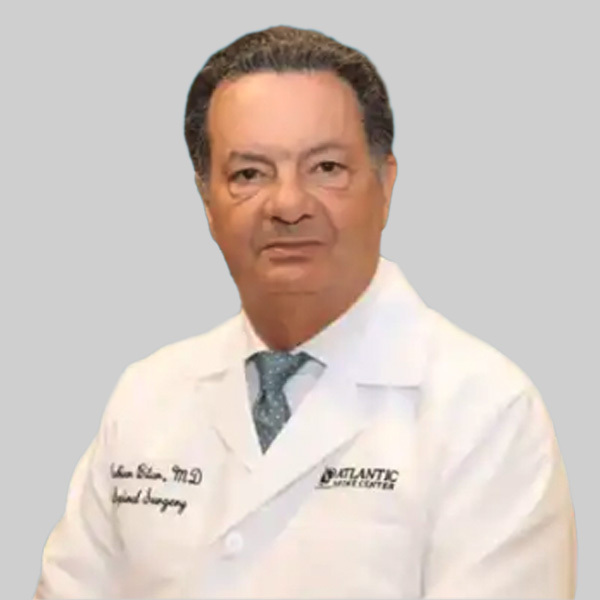Millions of adults experience lower back pain, but sciatica represents one of the most distinctive and debilitating forms of spinal discomfort. Affecting approximately 40% of Americans during their lifetime, sciatica typically develops in adults over 30 and becomes increasingly prevalent with age, rarely occurring in individuals under 20 years old.
Because sciatica symptoms can mimic those of other lower back conditions, consulting a qualified sciatica specialist is essential for an accurate diagnosis. Without proper identification of the underlying cause, you cannot receive the targeted treatment necessary to achieve lasting pain relief and restore normal function.
The encouraging news is that 80-90% of sciatica cases resolve successfully with conservative treatment approaches. However, when symptoms become severe or persistent, the experienced sciatica specialists at New York Bone & Joint Specialists provide the most advanced treatment options available in NYC.
What is Sciatica? Understanding the Condition
The sciatic nerve ranks among the largest nerves in your body, measuring approximately 2 centimeters in width. Rather than a single nerve, it consists of a complex network of five nerve roots that branch off from the spinal cord in your lower back. You have a sciatic nerve on each side of your body, extending from the lumbar spine through the hip and buttock region, down the back of each leg to just below the knee, where it branches to connect with the lower leg, foot, and toes.
Sciatica develops when the sciatic nerve becomes compressed, irritated, or inflamed, typically due to underlying spinal conditions such as herniated discs, bone spurs, or spinal stenosis. The medical term for any pinched nerve in the spine is radiculopathy, but sciatica specifically refers to compression affecting the sciatic nerve roots.
Symptoms of Sciatica vs. Radiculopathy: Key Differences
General Radiculopathy:
- Pain typically centers in the lower back region
- May extend to the buttocks, but rarely travels further
- Usually affects both sides equally
- Often described as aching, stiffness, or muscle spasm
Sciatica:
- Pain originates in the lower back but radiates down one leg
- Travels through the buttocks, hip, and leg, potentially reaching the toes
- Almost always affects only one side of the body
- Includes distinctive neurological symptoms: numbness, tingling, and burning sensations
Sciatica often begins as sudden, sharp pain in the lower back. As nerve compression worsens, the condition typically evolves into chronic pain accompanied by other neurological sensations that follow the sciatic nerve’s pathway through the buttocks and legs.
Sciatica Symptoms and Diagnosis
Due to the sciatic nerve’s extensive pathway, sciatica symptoms are distinctly different from other types of back pain, making accurate diagnosis crucial for effective treatment planning. Symptoms include:
- Unilateral leg pain: Chronic pain centered on one side of the leg or buttock, rarely affecting both sides simultaneously
- Movement-triggered pain: Sharp pain that intensifies when coughing, sneezing, bending forward, or performing straight leg raises while lying down
- Position-related discomfort: Pain that worsens when sitting and may improve with standing or walking
- Neurological sensations: Burning, tingling, pins-and-needles, or electric shock-like sensations along the nerve pathway
- Activity-related symptoms: Sharp pain during standing, walking, or transitioning between positions
- Motor deficits: Weakness, numbness, or difficulty moving the leg, foot, or toes
- Severe complications: Bladder or bowel incontinence (requiring immediate medical evaluation)
Critical Warning Signs: Bowel or bladder control issues represent the most serious sciatica symptoms and may indicate cauda equina syndrome, a medical emergency requiring immediate professional evaluation to prevent permanent nerve damage.
What Causes Sciatica?
Sciatica typically results from underlying spinal conditions that compress or irritate the sciatic nerve. Understanding these causes helps guide targeted treatment approaches and prevention strategies.
Primary spinal causes can include:
- Herniated or Bulging Disc: The most common cause of sciatica occurs when the soft inner material of a spinal disc pushes through its outer wall (herniation) or bulges outward, potentially compressing nearby sciatic nerve roots and causing inflammation.
- Degenerative Disc Disease: Age-related wear causes spinal discs to lose height, elasticity, and water content. As discs flatten and degenerate over time, they may press directly on the sciatic nerve or create spinal instability leading to nerve compression.
- Spinal Stenosis: Narrowing of the spinal canal or nerve root passages can compress sciatic nerve roots. This condition often results from bone spurs, thickened ligaments, or disc bulging that reduces available space for nerve structures.
- Piriformis Syndrome: The piriformis muscle, located deep in the buttock region near the base of the spine, can spasm or tighten, irritating the nearby sciatic nerve. In some individuals, the sciatic nerve passes directly through this muscle, making it particularly susceptible to compression.
- Spondylolisthesis: This condition occurs when one vertebra slips forward over the vertebra below it, creating misalignment that can compress nerve roots and cause sciatica symptoms.
Beyond spinal injuries and conditions, other causes of sciatica include:
Pregnancy-Related Changes: Hormonal changes during pregnancy soften supporting ligaments while the growing fetus adds weight and pressure to the spine, potentially causing nerve compression, particularly in the third trimester.
Lifestyle and Occupational Factors:
- Heavy lifting with improper technique
- Prolonged sitting or a sedentary lifestyle
- Repetitive bending and twisting motions
- Poor posture and ergonomic habits
Health and Lifestyle Risk Factors:
- Obesity, which increases spinal pressure and stress
- Smoking, which reduces blood flow to spinal structures and impairs healing
- Diabetes can affect nerve health and healing capacity
- Previous back injuries or trauma
Occupational Hazards: Jobs requiring frequent lifting, bending, prolonged sitting, or vibration exposure (such as truck driving) increase sciatica risk significantly.
“Sciatica pain doesn’t have to control your life – with the right diagnosis and personalized treatment plan, we can help you find lasting relief from that shooting pain down your leg. Our comprehensive approach combines advanced therapies with proven techniques to get you back to the activities you love without limitations.” – Dr. Leon Popovitz, MD, New York Bone & Joint Co-Founder.
Sciatica Treatment in New York: Comprehensive Care Options
At New York Bone & Joint Specialists, we provide a comprehensive, evidence-based approach to sciatica treatment that prioritizes conservative methods while offering advanced interventional and surgical options when necessary.
Conservative Sciatica Treatment Options
The vast majority of sciatica cases respond well to conservative methods and resolve within four to six weeks with at-home and conservative therapy. The goal of the treatments is to decompress the sciatic nerve and reduce pain.
- Hot and cold therapy. Apply a cold compress to the painful area to reduce swelling. After a few days, switch to a heating pad or warm compress to stimulate blood flow to the back.
- Pain medications. Over-the-counter non-steroidal anti-inflammatories (aspirin, naproxen, ibuprofen) can relieve pain. Your doctor can also prescribe an oral steroid or muscle relaxer.
- Physical therapy. A physical therapist can guide you through exercises to strengthen your core, support your back, and take pressure off the nerve. Stretching exercise can loosen muscles and reduce discomfort. A physical therapist can help you improve your posture.
- Activity modification and ergonomic changes. Lift heavy objects using the strength in your legs, not your lower back. If you sleep on your side, put a pillow between your bent knees.
- Epidural steroid injections. Corticosteroid injections can relieve severe pain for up to three months. The injections are done under local anesthesia.
- Manual therapy and chiropractic care. Massage therapy can unlock painful muscle spasms, while a chiropractor can adjust the spine.
- Alternative therapies. Deep tissue massage and acupuncture have proven effective in easing sciatica pain.
Sciatica Medical Procedures: Advanced Interventions
Sciatica treatment has advanced in recent years. Today, sciatica patients can choose one of several cutting-edge sciatica medical procedures.
Nerve block. Guided by a fluoroscopy (a real-time X-ray technology) or an ultrasound, the doctor injects a local anesthetic directly into the sciatic nerve. Pain relief may last two weeks to a few months.
Radiofrequency ablation. In this minimally invasive procedure, heat waves are pulsed into the sciatic nerve through a needle to block pain signals from reaching the brain. The procedure can resolve pain for four to six weeks, but it can last longer.
If sciatica is caused by disc degeneration or herniation, minimally invasive surgical techniques can help.
Microdiscectomy. The surgeon enters the spine through a half-inch incision and removes the herniated portions of the disc. Patients can walk a few hours after surgery and can return to work in a few days.
Laminectomy. This procedure removes part of the spinal bone to ease pressure on the spinal cord or sciatic nerve. Patients can realize a full recovery in four to six weeks.
Disc replacement. The damaged disc is removed and replaced with a prosthetic “spacer” or artificial disc. No screws or plates are inserted to keep the new disc in place. Normal activities can be resumed in weeks, but full recovery can take a few months.
Spinal fusion. Reserved for significant herniation, spinal fusion combined with a discectomy removes the disc or the herniated disc fragment. The surgeon then fuses the vertebrae above and below where the removed disc was to stabilize the spine. Patients can walk the same day as surgery and gradually build up their activity level. Recovery could extend for several months for patients who work at strenuous jobs.
When Surgery is Necessary for Sciatica
Since conservative methods are successful in treating sciatica, surgery is rarely recommended. However, in some instances, it may be warranted.
- Persistent pain. Pain not helped by conservative methods after six to eight weeks.
- Quality of life restrictions. Difficulty and pain in performing everyday tasks, such as walking.
- Referred symptoms. Bladder and bowel control issues.
Cauda equina syndrome emergency. A rare disorder, cauda equina syndrome, affects the nerves at the lumbar spine. Immediate surgery is necessary to prevent urinary incontinence and possible paralysis.
Minimally invasive vs. traditional open surgeries. Minimally invasive surgeries use small incisions to lessen the chance of nerve and tissue damage. Recovery is also shorter. Traditional open operations enter the surgical site with a larger incision.
Stretches for Sciatica: Therapeutic Exercise Approach
Conservative methods offer the best chance of recovery, with stretching exercises the most beneficial. A physical therapist at New York Bone & Joint can discuss these exercises and others.
Hamstring stretches
Piriformis Stretch (for piriformis syndrome relief):
- Lie on your back with both legs straight
- Lift your affected leg and bend the knee toward your chest
- Using your opposite hand, gently pull the knee toward your opposite shoulder
- Hold for 30 seconds, feeling the stretch in your buttocks and hip region
- Repeat 2-4 times, then perform with the other leg
- Progression: As flexibility improves, increase hold time to 60 seconds
Hamstring Stretches (to reduce posterior chain tension):
Classic Standing Hamstring Stretch:
- Stand facing a step, chair, or elevated surface
- Place your heel on the surface with leg straight and foot flexed upward
- Keep your spine straight and slowly lean forward until you feel a stretch behind your thigh
- Hold for 30 seconds, avoiding bouncing or forcing the stretch
- Repeat 2-3 times each leg, gradually increasing hold time as flexibility improves
Supine Hamstring Stretch (gentler alternative):
- Lie on your back with one leg extended on the floor
- Use a towel or exercise strap around the foot of the other leg
- Keeping the leg straight, gently pull upward until you feel a comfortable stretch
- Hold 30 seconds, repeat 2-3 times on each side
Knee-to-Chest Stretch (for spinal decompression):
- Lie on your back with legs extended, avoiding excessive back arching
- Slowly bring one knee toward your chest
- Grasp behind or on top of the knee with both hands
- Gently pull until you feel a mild stretch in your lower spine and hip
- Hold 15-30 seconds, then slowly lower the leg
- Repeat 3-5 times for each leg
Follow proper technique. Stretches for sciatica should be done in slow, controlled movements. If pain worsens, speak to your physical therapist. You may need to adjust how you perform the stretch to make it more comfortable.
Stretches to avoid. Avoid any exercise that puts extra stress on the lower back. That would include double leg lifts, leg circles, and forward bends. Don’t do exercises involving excessive twisting.
Why choose us for Sciatica treatment in NYC?
New Yorkers have trusted our sciatica specialists for decades. Our leadership in the field is a testament to:
- Comprehensive & Compassionate Care: Our world-class specialists provide expert, empathetic guidance from diagnosis through rehabilitation.
- Commitment to Joint Health: We prioritize your joint health and healing, understanding the vital role joints play in an active and fulfilling life.
- Effective Non-Surgical Solutions: We successfully resolve over 90% of ankle pain cases with orthopedic treatments, often avoiding surgery.
- Dedication to Your Full Recovery: We are committed to your complete recovery, using conservative methods and only resorting to expert surgical intervention when necessary.
NYC’s Top-Rated Sciatica Specialists
At New York Bone & Joint Specialists, our philosophy is to preserve your body’s natural structures, especially for long-term sciatica recovery. Our commitment to exceptional care means 90% of our patients recover without surgery, ensuring lasting health and function, and offering peace of mind.
Make an appointment today
Ready to take the first step toward relief? Schedule an appointment with New York Bone & Joint Specialists and start your personalized recovery plan today.
Sciatica: FAQs
How do I find the best sciatica specialist near me?
Search for an orthopedist near you who specializes in spinal nerve conditions, like sciatica, spinal stenosis, and disc degeneration. A sciatica specialist has the training and expertise to accurately diagnose the root cause of sciatica. At New York Bone & Joint Specialists, our physicians use state-of-the-art technology to determine what is causing your lower back pain. We will develop a treatment plan based on your individual needs.
What are the most effective stretches for sciatica?
Stretches that target the hips, lower back, and hamstrings increase flexibility in the muscles around the lumbar spine. These exercises can also relieve pressure on the sciatic nerve. A physical therapist can show the proper stretching techniques.
What medical procedures are available for sciatica?
Most sciatica cases respond well to home care (hot/cold therapy, rest, OTC pain relievers) and physical therapy focused on strengthening and stretching the core muscles. Non-surgical methods such as corticosteroid injections, nerve blocks, and deep massage therapy are effective as well. If conservative methods fail to bring relief, several minimally invasive surgeries can alleviate sciatica pain, but such procedures are reserved for rare cases not helped by conservative therapies.
When should I see a sciatica specialist?
The pain persists even after weeks of conservative treatments. Loss of bowel and bladder control needs to be evaluated by a sciatica specialist for further treatment.
How long does sciatica take to heal?
With at-home and conservative treatments, sciatica can heal within four to six weeks. Any pain beyond that needs medical attention and/or a structured physical therapy program.
What’s the difference between sciatica and general back pain?
General lower back pain typically centers in the lower back or possibly the buttocks. Sciatica pain extends further than the lower back and into the buttocks, hip, legs, and toes. Numbness, tingling, and burning sensations in the lower limbs are also typical of sciatica.
Can I exercise with sciatica?
Yes, you can. Activity is good for sciatica. But consult with a physical therapist before starting a workout routine. Some movements can exacerbate sciatica pain, including twisting and deep bending.










